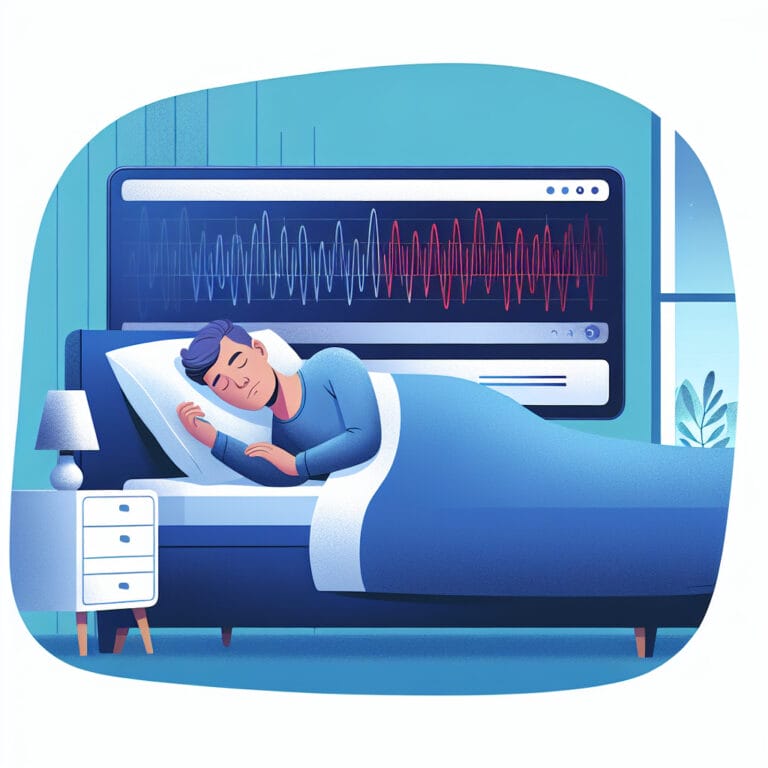
Understanding the Stages of Sleep: Defining Slow-Wave Sleep
Table of Contents
- Introduction
- Understanding the Sleep Cycle
- Defining Slow-Wave Sleep
- How to Improve Slow-Wave Sleep
- Conclusion
- Frequently Asked Questions
Introduction
Contrary to popular belief, sleep is not a passive state of rest but rather an active period where vital physical and mental restoration occurs. The importance of slow-wave sleep, also referred to as deep slow-wave sleep or stage 3 sleep, cannot be overstated. Occupying approximately 20-25% of an adult’s total sleep time, it represents the deepest stage where the body physically restores itself. During this phase, human growth hormone is released aiding in muscle repair and growth while delta waves – the slowest and highest amplitude brain waves – dominate your sleep EEG indicating profound relaxation and restorative tranquility.
As part of the non-rapid eye movement (NREM) segment of your sleep cycle, it stands distinct from REM sleep where dreams tend to occur. It’s during this deep slumber that cellular regeneration takes place, energy is replenished and immune system strengthened – fundamentally fortifying daytime functioning. Research in sleep medicine has shown that deprivation of slow-wave-sleep can result in reduced daytime alertness and cognitive performance.
Moreover, it plays a crucial role in memory consolidation: studies suggest learning abilities are enhanced with increased Slow Wave Sleep (SWS). Consequently, disrupted or inadequate SWS can lead to sleep disorders including primary insomnia or impede recovery from a demanding day affecting overall mental health.
In essence, prioritizing quality over quantity by focusing on promoting more periods of sustained deep slow wave activity (SWA) could be key for better health outcomes. From improving your bedtime routine with good ‘sleep hygiene’ practices like maintaining consistent bedtimes to investing in a comfortable memory foam mattress that supports falling asleep effortlessly – every step towards optimizing your nighttime repose would enhance these beneficial bouts of profound peace.
Understanding the Sleep Cycle
While it might seem like there are distinct borders between the three stages of sleep – light sleep, deep slow-wave sleep, and REM (rapid eye movement) sleep – in reality, they exist on a dynamic continuum that shapes our total sleep time. Light sleep marks the onset of your slumber journey; your muscles relax, heart rate slows down and body temperature drops. This transitional phase readies you for the deeper stages to follow.
Stepping into deep slow-wave sleep is like crossing a threshold into tranquility where vital recovery processes unfold. It’s during this deepest stage when slow waves dominate your sleep EEG and human growth hormone surges through your body, promoting muscle repair and growth. Delta waves- signifying profound relaxation- epitomize this stage’s restorative power. The importance of nurturing this phase to optimize daytime functioning can’t be overstated: adults spend about 20-25% of their time asleep cocooned in this phase.
Contrasting with NREM (non-rapid eye movement) stages is REM Sleep where dreams tend to manifest vividly as if woven together by an imaginative storyteller in the brain’s frontal areas. Intriguingly, despite being named ‘rapid eye movement’ owing to characteristic flickering eyes beneath closed lids – skeletal muscles experience atonia or temporary paralysis in this stage possibly preventing us from acting out dreams while our minds roam free.
Each stage offers its unique contribution: while REM bolster creativity and emotional regulation; deep slow-wave sleep has functional correlates with cognitive performance enhancement following a good night’s sleep as well as crucial roles in memory consolidation and physical rejuvenation; whereas light sleeper serves as both an introductory prelude easing you into deeper realms as well as a closing chapter gently bringing you back towards wakefulness post REM episodes.
Inevitably, individual differences exist in how we traverse these stages: some may transition smoothly while others could struggle due to various reasons ranging from primary insomnia to poor sleep hygiene. But, a consistent endeavor towards improving our sleep quality – be it through maintaining regular bedtimes or investing in a comfortable memory foam mattress – can bring us closer to the restorative bliss of a truly good night’s sleep.
| Stage | Description | Benefits | Typical Duration |
|---|---|---|---|
| Light Sleep | Marks the onset of the sleep cycle. Muscles relax, heart rate slows down, and body temperature drops, preparing you for deeper stages of sleep. | Serves as both an introductory prelude easing you into deeper sleep and a closing chapter bringing you back towards wakefulness post REM episodes. | Varies |
| Deep Slow-Wave Sleep | A stage of profound relaxation and recovery. Slow waves dominate your sleep EEG and human growth hormone surges, promoting muscle repair and growth. | Enhances cognitive performance following a good night’s sleep; plays crucial roles in memory consolidation and physical rejuvenation. | Adults spend about 20-25% of their sleep time in this phase. |
| REM (Rapid Eye Movement) Sleep | Stage where dreams manifest vividly. Despite the rapid eye movement, skeletal muscles experience atonia or temporary paralysis, possibly preventing us from acting out dreams. | Boosts creativity and emotional regulation. | Varies |
Defining Slow-Wave Sleep
Unveiling the mysteries of slow-wave sleep (SWS) can offer profound insights into our overall well-being. While each stage of the sleep cycle – be it light sleep, REM sleep, or deep slow-wave sleep – has its unique contributions to our health and cognitive functioning, SWS holds a distinctive role as the deepest phase of non-rapid eye movement (NREM) slumber. This stage is characterized by an abundance of delta waves on your sleep EEG – signaling a state of deep relaxation and restorative tranquility.
But what makes this stage so significant? One key aspect lies in its functional correlates with memory consolidation and learning. During SWS, neural connections that form our memories are strengthened and integrated into our existing knowledge framework. Any disruption to this process due to poor quality or insufficient quantity of slow wave activity (SWA) can negatively affect these cognitive functions, leading to potential challenges in retaining new information.
Apart from enhancing cognition, studies in sleep medicine have also linked optimal SWS to various aspects of physical health. It’s during this deepest stage that the body physically restores itself – from muscle repair facilitated by human growth hormone release to strengthening immune defenses which fortifies daytime functioning while reducing susceptibility towards disease progression.
However, like all things biological, there exist individual differences in how we experience SWS; factors such as age or underlying medical conditions can influence total time spent in slow-wave slumber during a single night’s rest. Also noteworthy is that disorders like primary insomnia may stem from disrupted SWS patterns revealing complex associations between various stages within the overarching architecture of our sleep cycle.
In essence, nurturing quality slow wave sleep offers real-world benefits beyond merely waking up refreshed; it serves as a linchpin for improving both mental health and physical well-being while equipping us with fortified resilience against daytime challenges.
How to Improve Slow-Wave Sleep
Delving into the realm of sleep, one encounters an intriguing ebb and flow of sleep stages throughout the night. With each transitioning stage, from light sleep to REM sleep, our bodies undertake a restorative journey. However, the crown jewel that we should all strive for is deep slow-wave sleep – a phase when our body physically restores itself with the release of human growth hormone, and our mind rejuvenates through memory consolidation.
To optimise your time spent in this deepest stage of slumber and achieve a truly good night’s sleep, consider making intentional lifestyle changes aimed at enhancing your overall sleep quality. Maintenance of regular bedtimes plays a vital role in promoting better slow-wave activity (SWA), leading to improved daytime functioning and reduced daytime sleep propensity. Furthermore, investing in an optimized sleeping environment – such as equipping your bed with a comfortable memory foam mattress which can significantly aid in falling asleep effortlessly – is instrumental to nurturing total deep slow-wave sleep (SWS). Cutting back on caffeine or alcohol close to bedtime can also ensure optimal baseline sleep continuity.
Yet despite these efforts if you find yourself still suffering from disrupted SWS or other associated symptoms like excessive daytime fatigue indicating possible primary insomnia or other underlying conditions – don’t hesitate seeking guidance from professionals in Sleep Medicine. Remember that prioritizing this deepest stage where delta waves abound not only guarantees refreshing recovery sleeps but also serves as cognitive armoury against real-world challenges – indeed offering profound insights beyond what meets the ‘sleeping’ eye!
| Methods to Improve Slow-Wave Sleep | Description |
|---|---|
| Maintain Regular Bedtimes | Keeping a consistent sleep schedule can promote better slow-wave activity, leading to improved daytime functioning and reduced daytime sleepiness. |
| Invest in an Optimized Sleeping Environment | Creating a comfortable sleeping environment, such as using a memory foam mattress, can aid in falling asleep effortlessly and improving overall sleep quality. |
| Limit Caffeine and Alcohol Intake | Cutting back on caffeine or alcohol close to bedtime can ensure optimal baseline sleep continuity and enhance slow-wave sleep. |
| Seek Professional Guidance | If you still suffer from disrupted slow-wave sleep or other related symptoms, don’t hesitate to seek guidance from professionals in Sleep Medicine. |
Conclusion
Unlocking the secrets of slow-wave sleep can yield transformative benefits for your overall well-being. This deepest stage of slumber, often referred to as deep sleep or delta sleep due to abundant delta waves on your sleep EEG, is where the magic happens: bodily repair facilitated by human growth hormone, memory consolidation leading to enhanced cognitive performance and mental health fortification. However, disruptions in this crucial phase due to poor sleep hygiene or underlying conditions can lead to various sleep problems including primary insomnia. By prioritizing slow-wave activity (SWA) through maintaining consistent bedtimes, optimizing our sleeping environment with elements like a comfy memory foam mattress and moderating intake of stimulants near bedtime—we can foster a nurturing environment for slow-wave sleep (SWS). Remember that achieving quality over quantity in our total sleep time is key in conquering daytime challenges and safeguarding our health. As we delve deeper into the world of dreams with each passing Sleep episode, let’s embrace this profound wisdom: harnessing the power of Slow-Wave Sleep presents real-world insights for better living!


